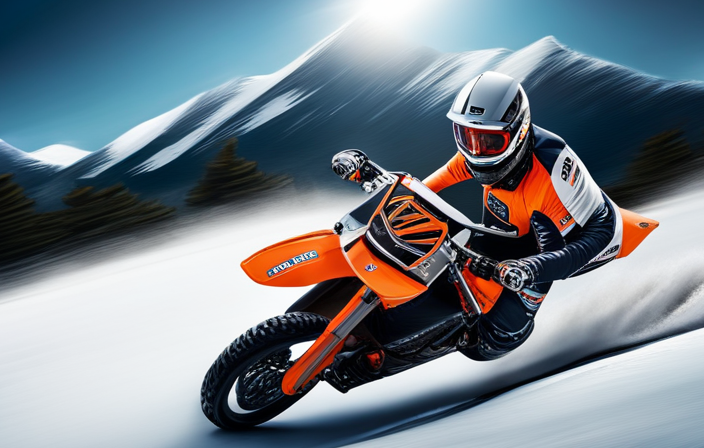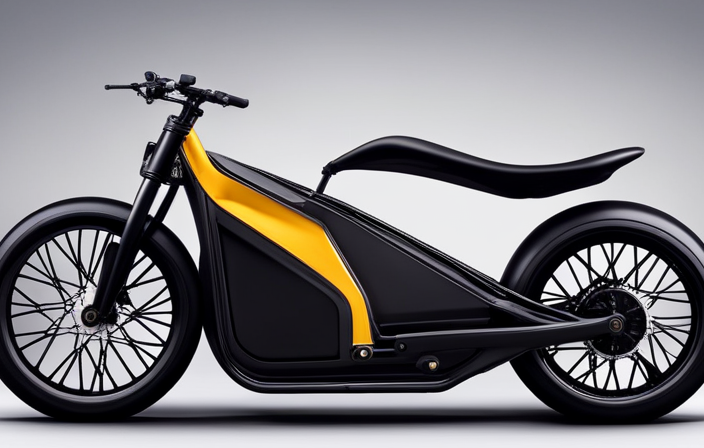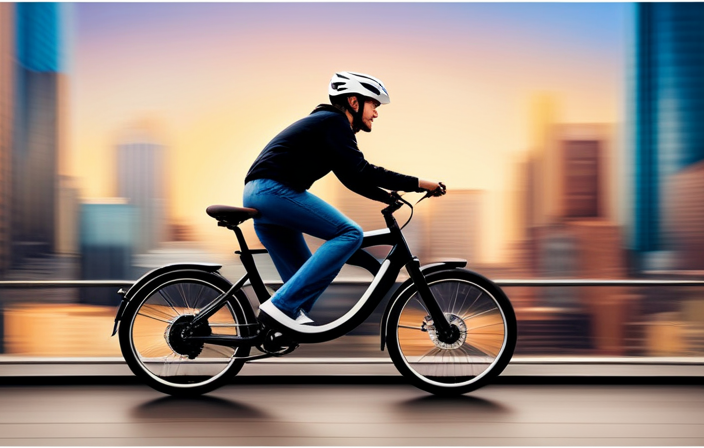I have always been intrigued by the high speeds that dirt bikes can achieve as a passionate dirt bike enthusiast. KTM has established itself as a prominent player in the industry of electric dirt bikes.
In this article, we will delve into the world of KTM electric dirt bikes and explore just how fast these cutting-edge vehicles can go. Get ready to be blown away by the sheer power and speed that these bikes can deliver on any off-road terrain.
Key Takeaways
- KTM electric dirt bikes offer adjustable suspension settings for various terrains, allowing for a customizable and comfortable riding experience.
- The torque-rich electric motors in KTM electric dirt bikes provide quick acceleration and climbing power, ensuring an exhilarating and capable ride.
- KTM electric dirt bikes require cost-effective maintenance with fewer moving parts, eliminating the need for oil changes or spark plug replacements.
- Charging the battery of a KTM electric dirt bike can be done at home or at charging stations, with an average charging time of 2 to 3 hours, providing convenience and flexibility for riders.
Overview of KTM Electric Dirt Bikes
KTM electric dirt bikes are becoming increasingly popular among off-road enthusiasts. With their powerful performance and cutting-edge technology, these bikes are revolutionizing the off-road riding experience.
KTM offers a range of electric dirt bike models, each designed to deliver top-notch performance and thrill. When it comes to performance comparison, the KTM Freeride E-XC stands out. Equipped with a 42 Nm torque electric motor, this bike provides impressive acceleration and power. Its lightweight frame and advanced suspension system ensure excellent handling and maneuverability on rugged terrains.
Moreover, the KTM Freeride E-XC boasts a long-lasting battery life, allowing for extended rides without worrying about running out of power.
With their exceptional performance and eco-friendly nature, KTM electric dirt bikes have numerous advantages over their traditional counterparts.
The Advantages of Electric Dirt Bikes
One of the advantages of electric dirt bikes is that they’re much quieter than their gas-powered counterparts. This not only provides a more pleasant riding experience but also reduces noise pollution, making them more environmentally friendly.
Here are some other advantages of electric dirt bikes:
- Zero emissions: Electric dirt bikes produce no exhaust emissions, contributing to cleaner air and a healthier environment.
- Instant torque: Electric motors deliver instant and consistent torque, providing powerful acceleration and better control on challenging terrains.
- Low maintenance: With fewer moving parts and no fuel or oil changes required, electric dirt bikes have lower maintenance costs and less downtime.
- Lightweight design: Electric dirt bikes often have lighter frames and components, allowing for improved maneuverability and agility on the trails.
Considering the environmental impact and the range of advantages, electric dirt bikes are a promising alternative to their gas-powered counterparts.
Now let’s delve into the exciting topic of the top speed of KTM electric dirt bikes.
Top Speed of KTM Electric Dirt Bikes
When it comes to the top speed of KTM electric dirt bikes, riders can expect an exhilarating and adrenaline-pumping experience. These bikes are designed to push the boundaries of speed and performance, providing riders with the ultimate off-road thrill.
Compared to traditional dirt bikes, KTM electric models offer top speed enhancements that truly set them apart. With the advancements in technology and performance upgrades, KTM has been able to achieve impressive top speeds that rival their gas-powered counterparts. Riders can expect to reach speeds of up to 60 miles per hour on some of the latest KTM electric dirt bike models.
This level of speed opens up a whole new world of possibilities for riders, allowing them to conquer challenging terrains with ease and precision. But top speed is just the beginning; let’s dive into the extraordinary acceleration and power of KTM electric dirt bikes.
Acceleration and Power of KTM Electric Dirt Bikes
Compared to traditional models, riders can expect the acceleration and power of KTM electric dirt bikes to be truly impressive. These bikes are designed to deliver a thrilling and exhilarating ride, packed with cutting-edge technology and engineering.
Here are three key features that make the acceleration and power of KTM electric dirt bikes stand out:
-
Instant torque: With their electric motors, KTM dirt bikes offer instantaneous torque, providing a quick burst of acceleration that can leave other bikes in the dust.
-
Lightweight design: KTM electric dirt bikes are built with lightweight materials, allowing for enhanced power efficiency and quicker acceleration.
-
Advanced power management: These bikes come equipped with state-of-the-art power management systems, ensuring that every ounce of power is utilized efficiently for maximum acceleration.
As we delve into the battery life and range of KTM electric dirt bikes, it becomes evident that these bikes have much more to offer beyond their impressive acceleration and power capabilities.
Battery Life and Range of KTM Electric Dirt Bikes
The battery life and range of KTM electric dirt bikes are impressive, allowing riders to go for long distances without worrying about running out of power. The battery performance of KTM electric dirt bikes is a key factor in their success.
These bikes come equipped with high-capacity lithium-ion batteries that provide a substantial amount of energy, giving riders the ability to explore off-road trails for extended periods of time. The range of KTM electric dirt bikes varies depending on the model, but on average, they can cover distances of up to 50 miles on a single charge.
To ensure that riders have access to charging infrastructure, KTM has been actively working on expanding its network of charging stations. This commitment to supporting the growing number of electric dirt bike riders further enhances the overall experience.
Now, let’s explore how KTM electric dirt bikes compare to their traditional counterparts.
Comparison to Traditional Dirt Bikes
You’ll notice a significant difference when riding a traditional dirt bike compared to the KTM electric model. While gas-powered dirt bikes have been the norm for years, the KTM electric dirt bike offers a new and innovative alternative.
When it comes to performance, the electric model provides instant torque and acceleration, giving riders an exhilarating and responsive experience.
In terms of environmental impact, electric dirt bikes are much cleaner and quieter than their gas-powered counterparts. They produce zero emissions and have a reduced noise level, making them more environmentally friendly and less disruptive to the surrounding areas. This makes electric dirt bikes a great option for riders who are conscious of their carbon footprint and want to enjoy the thrill of off-road riding while minimizing their impact on the environment.
Moving on to off-road performance and handling…
Off-Road Performance and Handling
As we delve deeper into the world of KTM electric dirt bikes, let’s shift our focus to their off-road performance and handling. These bikes are designed to conquer even the most challenging terrains with ease. With their powerful electric motors and advanced suspension systems, KTM electric dirt bikes offer an exhilarating riding experience.
Here are some key factors that contribute to their exceptional off-road performance:
- Aggressive tread pattern on the tires for maximum traction
- Rugged and durable frame construction for enhanced durability
- Adjustable suspension settings to adapt to various terrains
- Torque-rich electric motors for quick acceleration and climbing power
Now, let’s transition into the next section, where we will discuss the maintenance and charging requirements to keep these impressive machines running smoothly.
Maintenance and Charging Requirements
Let’s now shift our focus to the maintenance and charging requirements of these impressive machines.
When it comes to maintenance, KTM electric dirt bikes offer a cost-effective solution. With fewer moving parts compared to their gasoline-powered counterparts, the maintenance cost is significantly lower. Routine tasks such as oil changes and spark plug replacements are no longer necessary, saving both time and money.
Charging the bike’s battery is a straightforward process that can be done at home or at charging stations. The charging time may vary depending on the model and the charger used, but on average, it takes around 2 to 3 hours to fully charge the battery.
Now, let’s delve into the fantastic safety features of KTM electric dirt bikes.
Safety Features of KTM Electric Dirt Bikes
The safety features of KTM’s electric dirt bikes include advanced braking systems and protective gear for riders. KTM has implemented several innovative features to ensure rider protection on their electric dirt bikes. Here are three key safety features that KTM has incorporated into their electric dirt bikes:
-
Advanced Braking Systems: KTM’s electric dirt bikes are equipped with advanced braking systems that provide excellent stopping power and control. These systems enhance the rider’s ability to stop quickly and safely, even in challenging off-road conditions.
-
Protective Gear: KTM understands the importance of rider safety and provides protective gear such as helmets, body armor, and knee and elbow pads. This gear offers maximum protection without compromising comfort and maneuverability.
-
Compliance with Safety Regulations: KTM ensures that their electric dirt bikes meet all necessary safety regulations set by authorities. This includes aspects like lighting systems, reflectors, and other safety features required for riding on public roads.
With these safety features in place, riders can confidently enjoy their KTM electric dirt bikes while adhering to safety regulations. Looking ahead, let’s explore the exciting future developments in electric dirt bike technology.
Future Developments in Electric Dirt Bike Technology
You’ll be excited to learn about the future advancements in technology for off-road motorcycles.
The world of electric dirt bikes is evolving rapidly, with manufacturers constantly pushing the boundaries to improve performance, efficiency, and sustainability.
In terms of future innovations, we can expect to see significant improvements in battery technology, allowing for longer ride times and faster charging.
Additionally, advancements in motor design will enhance power delivery and responsiveness, providing riders with a thrilling and exhilarating experience.
It’s not just about performance though; environmental impact is also a key focus. Manufacturers are investing in sustainable materials, developing eco-friendly manufacturing processes, and exploring ways to reduce emissions.
The future of electric dirt bikes is promising, with exciting developments on the horizon that will revolutionize the off-road riding experience while minimizing our impact on the environment.
Frequently Asked Questions
What is the weight of a KTM electric dirt bike?
The weight of a KTM electric dirt bike is a crucial factor in its performance. It is designed to be lightweight, allowing for better maneuverability and control on off-road terrain.
Can a KTM electric dirt bike be used for motocross racing?
Sure, a KTM electric dirt bike can definitely be used for motocross racing. Its high-performance capabilities make it a great choice for racing. However, it’s important to keep up with regular maintenance to ensure optimal performance on the track.
How long does it take to fully charge a KTM electric dirt bike?
To fully charge a KTM electric dirt bike, it typically takes around 2 to 4 hours, depending on the charging capacity. It’s important to note that the charging time may vary based on the specific model and charger being used.
Are there any government incentives or rebates available for purchasing a KTM electric dirt bike?
There are numerous government incentives and rebates available for purchasing a KTM electric dirt bike. These incentives are a result of strict government regulations and a growing concern for the environmental impact of traditional dirt bikes.
Can a KTM electric dirt bike be used in wet or muddy conditions?
Yes, a KTM electric dirt bike can be used in wet or muddy conditions. The bike is equipped to handle these conditions with its waterproof components and durable construction. However, the battery life may be affected by the muddy terrain.
Conclusion
Well, folks, after all this talk about the speed and power of KTM electric dirt bikes, I must say, I’m thoroughly underwhelmed.
I mean, who needs a bike that can go from 0 to 60 in a matter of seconds? Or a battery that can last for hours on end? It’s not like we want to spend more time riding and less time charging, right?
And safety features? Pffft, who needs those?
I guess if you’re into top-notch performance and cutting-edge technology, then maybe, just maybe, a KTM electric dirt bike might be worth considering.
But hey, what do I know? I’m just a humble writer.









